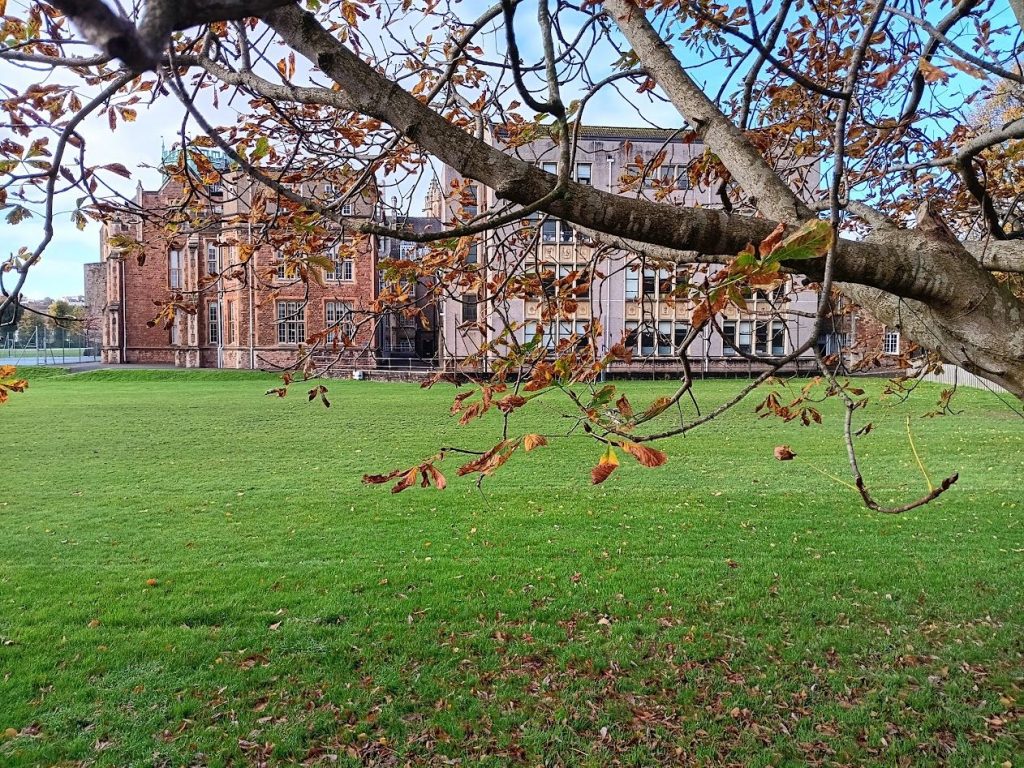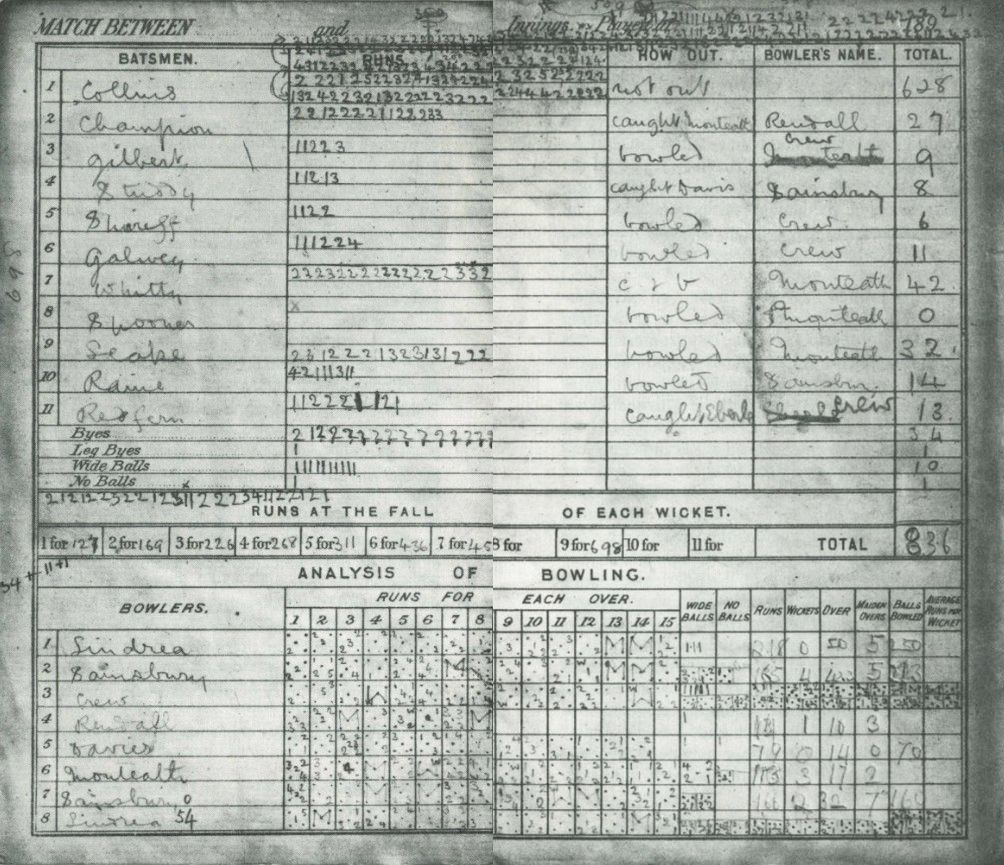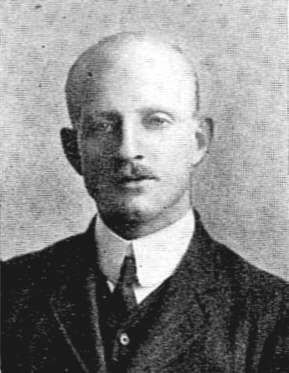Contents
Introduction

Arthur Edward Jeune Collins (1885 – 1914) held the record of the highest score in cricket for 116 years. As a 13-year-old schoolboy, he scored 628 not out over four afternoons in June 1899 in an inter-house match at Clifton College, where he was a pupil. Despite this achievement, Collins never played first-class cricket, though he did play at Lord’s. The record was eclipsed in January 2016 when an Indian boy, Pranav Dhanawade, scored 1009 in a single innings. This page presents a few more details about Collins’ famous achievement.
The innings created an international interest. For example picture of Collins was marketed as a 1899 postcard, and thousands of copies were sold around the world as the story spread.
Biography
An excellent booklet published by the Bristol branch of the Historical Association of the University of Bristol in 1991. I suggest you read this in presentation mode – press the right-pointing chevrons below, and select the first option.
Clifton College and Collins’ Piece

This is a view of the magnificent Close Ground, Clifton College, immortalised in the first line of Vitaï Lampada, a famous poem by John Newbold, the first verse of which is –
There's a breathless hush in the Close to-night -- Ten to make and the match to win -- A bumping pitch and a blinding light, An hour to play and the last man in. And it's not for the sake of a ribboned coat, Or the selfish hope of a season's fame, But his Captain's hand on his shoulder smote -- 'Play up! play up! and play the game!'
The poem goes on to compare the playing of cricket with fighting for one’s country – something that Collins was to learn all about in later life.
This ground was used by Gloucestershire for 96 first-class matches between 1871 and 1932 and witnessed 13 of W. G. Grace’s first-class hundreds. A fitting site for the record – maybe, but this was not quite where the innings was played…

Rather, it was around the corner in the very thin strip of field to the right of the photograph, beyond the school buildings and the hard-surface tennis court and alongside the church (former church actually, now apartments). It is now known as Collins’ Piece and is still used for sport, but is far too small for a cricket match in modern times. Five-a-side football is more normal.

The black oval approximately indicates the location of Collins’ Piece. It lies alongside the Guthrie Road, behind a medium-sized wall. It can be viewed by passers-by by sneaking in the drive alongside the former church adjacent to the ground.

Collins’ Piece from the grounds of the former church. The old building is the junior school. The wicket itself was more or less in line with the gap between the buildings, which is about the halfway line of the five-a-side football field. The two straight boundaries only extended around 20 yards beyond the stumps and reaching them earned a mere two runs, with one exception – the modern build you can just about see was a set of fives courts and beyond them was a swimming pool – to hit the ball into the pool earned six. The boundary to the right was 70 yards away, and sixes could be scored there as well by clearing the wall – I am not sure if a hit along the ground to this boundary counted as two or four. To the left, the land continued for a considerable distance, and runs in this area had to be run in full. Declarations were not permitted, which is why Collins’ innings continued over several days.

To the right of the modern building is another old building, adjacent to a set of gates leading to Guthrie Road. Above a window of this building is a plaque, unveiled in 1962, commemorating Collins’ innings:

Following Pranav Dhanawade’s innings (see below), it is out-of-date.
Less than a mile from Collins’ Piece is the elegant Victoria Square, where WG Grace lived and practised as a doctor from 1894 to 1896. Grace’s son, WG Grave Jr (1874-1907) attended Clifton College.
The Innings

Collins and World War I

In 1903, Collins joined the army, and by 1914, the year he married, he was Lieutenant Arthur Collins of the Royal Engineers. The first Battle of Ypres began on 19 October of that year, not long after his 29th birthday. The British Expeditionary Force’s final decisive push of that battle came on 11 November, the day Collins was mortally wounded, and was carried back to his company’s trenches to die. He was buried, but no grave was marked, and his official memorial is his name and rank recorded on the Menin Gate at Ypres. Two of Collins’ brothers – Norman and Herbert – also died in the war.
A poignant fact – of the 22 under-14 schoolboys who played in this match, 16 went to war and did not survive to see 1918’s Armistice Day. With astonishing irony, a statue of Clifton alumnus, General Haig, aka Butcher of the Somme, was erected in 1931 and overlooks the playing fields.
Highest Score Records
The previous record for the highest score was held by A.E. Stoddart – in 1886, he scored 485 in 370 minutes for Hampstead against Stoics, all after spending the entire night before the game playing poker. Stoddart later became England’s captain. After Collins’s feat, seven other scores of over 500, and one near miss, have been recorded:
- In March 1902, 31-year-old Australian Test cricketer Charles Eady came close to breaking the record, when he made 566 for Break-o’-Day against Wellington in Hobart in less than eight hours spread over three weeks.
- In 1914, JC Sharp, playing for Melbourne GS v Geelong College, at Melbourne scored 502 not out.
- In 1933, Dadabhoy Havewala playing for Bombay Baroda & Central India Railways v St Xavier’s College at Mumbai scored 515.
- In 1956, Malhotra Chamanlal playing for Mohindra College, Patiala, v Government College scored 502 not out.
- In January 1959, Hanif Mohamed surpassed Don Bradman’s record for the highest individual first-class innings, which was 452. Hanif made 499 for Karachi in a match against Bahawalpur before being run out attempting his five hundredth run.
- In 1994, Brian Lara broke Hanif’s record for the highest individual score in first-class cricket when he made 501 not out for Warwickshire against Durham at Edgbaston. Lara also holds the highest test score record, 400 not out for the West Indies against England in 2004.
- In 2013, Prithvi Shaw playing for Rizvi Springfield in a Harris Shield match scored 546.
- On 4 and 5 January 2016, Pranav Dhanawade, a 15-year-old Indian boy, scored 1009 not out from 323 balls for KC Gandhi School against Arya Gurukul School in Mumbai. It is often said that the opponents were all 10-year-olds and the boundaries were just 30 yards. As of 2025, Dhanawade plays adult recreational cricket at a good standard, but has yet to play in the first-class game, and, realistically, is unlikely to do so.
The highest score in any class of women’s cricket, as far as I am aware, is 242 scored by Kiran Baluch for Pakistan in a test match against England in March 2004.
Links
- Article by Martin Williamson on CricInfo highly recommended
- BBC feature
- Article by Frank Keating of The Guardian highly recommended
- Article from The Times (paywall)

